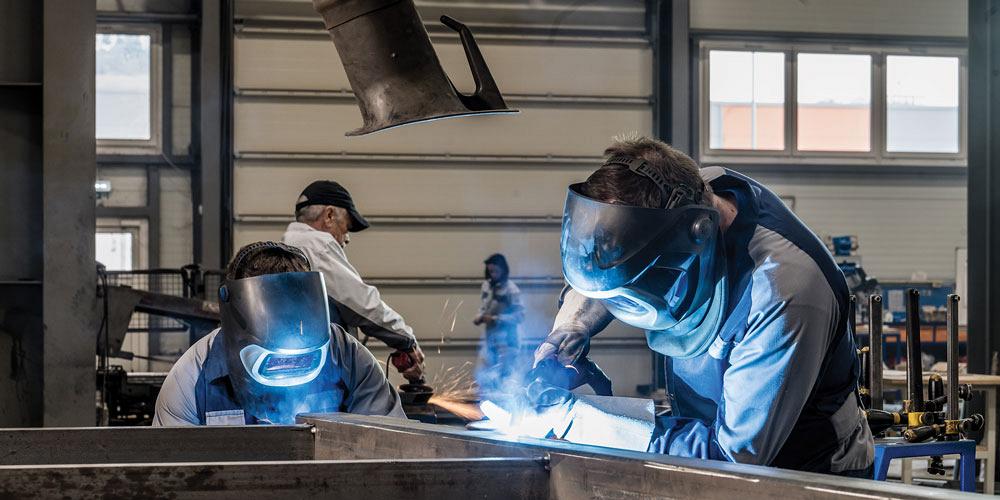- FMA
- The Fabricator
- FABTECH
- Canadian Metalworking
Economic trends and opportunities for welders in 2024
An economic guide for the welding industry in 2024
- April 8, 2024
As 2024 gets underway, the welding industry, along with the broader industrial and construction sectors, is navigating difficult and disruptive economic conditions. The most recent Provincial Economic Outlook report from the Royal Bank of Canada released in December gives a full picture of the economic forces at play. It shows how the global slowdown, the strength of the U.S. economy, and Canada's slower performance are all connected.
The following is a summary of these ideas, with a focus on the welding sector and how it can best navigate these uncertain times.
International Economic Challenges and Their Impact on Canada
The global economy has suffered the impact of central bank interest rate hikes, as well as high food and energy prices. This climate has resulted in a slowdown, indicating a moment of economic reset. In the U.S., economic performance has shown unexpected resiliency, with adequate GDP growth through the third quarter of 2023. However, growth is likely to take a dip in early 2024 as household savings decline and demand for labour slows down.
With a 1.1 per cent yearly drop in GDP in the third quarter of 2023, Canada's economy continues to exhibit a downward trend. This slowdown is emphasized by falling consumer spending per person, rising unemployment, and a significant drop in job openings—a 30 per cent year-over-year decrease as of September. These signs show that people are having a hard time with higher living costs and higher debt payments, which is lowering their buying power even though they are saving a good amount of money.
These larger economic trends mean that the welding sector needs to be careful and make plans ahead of time. When businesses and people cut back on spending, it affects the demand for welding and manufacturing services, which in turn affects the health of the sector. With business investment in machinery and equipment on the decline and a housing market impacted by high interest rates and population growth, the immediate outlook calls for resilience and adaptability.
Hope for 2024
The research reveals a bright side: GDP growth is likely to pick up again in the second half of 2024. However, the challenges of family debt will remain until 2025. This prediction gives the welding sector some hope but with a note of caution. The recovery in business investment could boost demand for welding services, especially in industries like manufacturing and building that are set to benefit from a stronger economy.
The economic prediction differs greatly between provinces, with limited growth expected in Ontario, British Columbia, and Quebec. The variation between regions highlights the significance of diversifying markets and making strategic investments in regions that are seeing more robust growth. These regions include the Prairies and some parts of the Atlantic, which are boosted by a boom in natural resource products and construction investment.
Industry-Specific Insights from Q3 2023
The third quarter of 2023 was an uncertain time for businesses that are important for fabrication and welding. During the same period last year, the GDP for the construction industry decreased by 1.1 per cent, while the transportation and warehouse business grew by 5.1 per cent. These trends emphasize the welding industry's sector-specific difficulties and opportunities, with transportation and manufacturing showing promise for growth.
However, the downturn in construction indicates that the welding sector must pivot and adapt, potentially by exploring opportunities in maintenance, repair, and retrofitting, which may see higher demand in a slowing construction market.
Looking Ahead
Inflation remains a critical concern, with the consumer price index rising to 3.9 per cent as of December 2023. For the welding sector, this means having to deal with increased costs for materials like steel, which saw a year-over-year decline of 24.5 per cent as of December but remains unstable. To stay competitive, companies will need to control costs well and source materials in a smart way. As prices for commodities change and housing prices drop, the welding industry needs to remain agile by using new technologies and looking for new markets and uses for welding and manufacturing services.
The welding industry's economic outlook is complex, with both short-term obstacles and long-term potential. Businesses in the welding industry can get through these tough times with strength and insight if they understand these economic trends and plan ahead. To make sure the industry not only survives but continues to thrive in the years to come, it's important to keep an eye on both local and global economic indicators and focus on innovative practices.
This economic outlook was compiled by CWB Group’s Research Team, 8360 Parkhill Dr., Milton, Ont. L9T 5V7, 800-844-6790, cwbgroup.org.
subscribe now


Keep up to date with the latest news, events, and technology for all things metal from our pair of monthly magazines written specifically for Canadian manufacturers!
Start Your Free Subscription- Trending Articles
Aluminum MIG welding wire upgraded with a proprietary and patented surface treatment technology

Achieving success with mechanized plasma cutting

Hypertherm Associates partners with Rapyuta Robotics

Gema welcomes controller

Brushless copper tubing cutter adjusts to ODs up to 2-1/8 in.

- Industry Events
MME Winnipeg
- April 30, 2024
- Winnipeg, ON Canada
CTMA Economic Uncertainty: Helping You Navigate Windsor Seminar
- April 30, 2024
- Windsor, ON Canada
CTMA Economic Uncertainty: Helping You Navigate Kitchener Seminar
- May 2, 2024
- Kitchener, ON Canada
Automate 2024
- May 6 - 9, 2024
- Chicago, IL
ANCA Open House
- May 7 - 8, 2024
- Wixom, MI
















